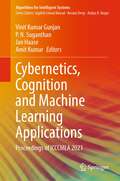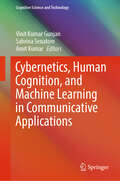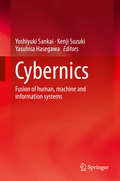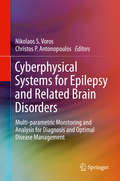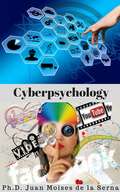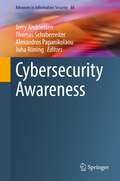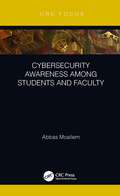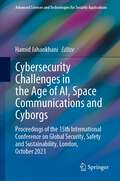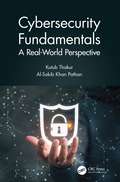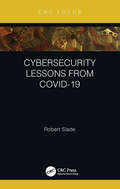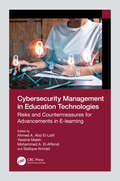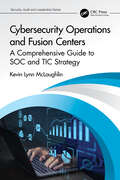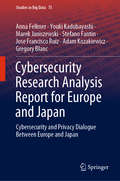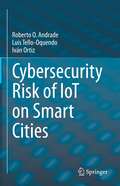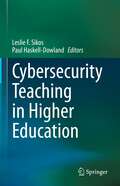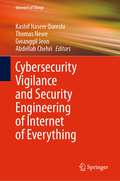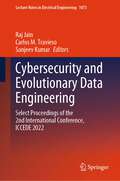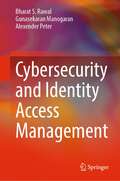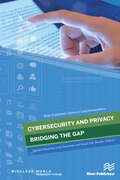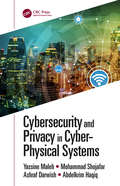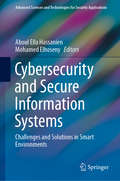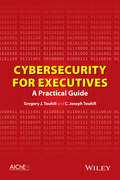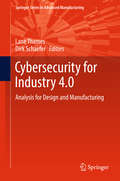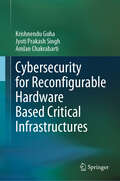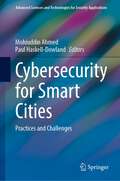- Table View
- List View
Cybernetics, Cognition and Machine Learning Applications: Proceedings of ICCCMLA 2021 (Algorithms for Intelligent Systems)
by Amit Kumar Vinit Kumar Gunjan Jan Haase P. N. SuganthanThis book includes the original, peer-reviewed research articles from the 3rd International Conference on Cybernetics, Cognition and Machine Learning Applications (ICCCMLA 2021), held in August 21 – 22, 2021, at Goa, India. It covers the latest research trends or developments in areas of data science, artificial intelligence, neural networks, cognitive science and machine learning applications, cyber physical systems and cybernetics.
Cybernetics, Human Cognition, and Machine Learning in Communicative Applications (Cognitive Science and Technology)
by Amit Kumar Vinit Kumar Gunjan Sabrina SenatoreThis book presents the fascinating intersection of human cognition and artificial intelligence. Written by leading experts in the fields of cybernetics, cognitive science, and machine learning, this book seeks to bridge the gap between these disciplines and explores the synergies that emerge when humans and machines work together. The book examines the challenges posed by biased data, lack of transparency, and the "black box" nature of some machine learning algorithms. It proposes novel ways to address these issues and foster greater trust and accountability in AI systems. Drawing on cutting-edge research and real-world case studies, it presents a comprehensive and forward-looking perspective on the future of AI and its impact on society. In conclusion, this book offers a compelling exploration of the synergy between human cognition and machine learning, providing insights that are relevant to scholars, researchers, policymakers, and anyone interested in the transformative potential of artificial intelligence.
Cybernics: Fusion of human, machine and information systems
by Yoshiyuki Sankai Kenji Suzuki Yasuhisa HasegawaCybernics plays a significant role in coping with an aging society using state-of-the-art technologies from engineering, clinical medicine and humanities. This new interdisciplinary field studies technologies that enhance, strengthen, and support physical and cognitive functions of human beings, based on the fusion of human, machine, and information systems. The design of a seamless interface for interaction between the interior and exterior of the human body is described in this book from diverse aspects such as the physical, neurophysiological, and cognitive levels. It is the first book to cover the many aspects of cybernics, allowing readers to understand the life support robotics technology for the elderly, including remote, in-home, hospital, institutional, community medical welfare, and vital-sensing systems. Serving as a valuable resource, this volume will interest not only graduate students, scientists, and engineers but also newcomers to the field of cybernics.
Cyberphysical Systems for Epilepsy and Related Brain Disorders: Multi-parametric Monitoring and Analysis for Diagnosis and Optimal Disease Management
by Nikolaos S. Voros Christos P. AntonopoulosThis book introduces a new cyberphysical system that combines clinical and basic neuroscience research with advanced data analysis and medical management tools for developing novel applications for the management of epilepsy. The authors describe the algorithms and architectures needed to provide ambulatory, diagnostic and long-term monitoring services, through multi parametric data collection. Readers will see how to achieve in-hospital quality standards, addressing conventional "routine" clinic-based service purposes, at reduced cost, enhanced capability and increased geographical availability. The cyberphysical system described in this book is flexible, can be optimized for each patient and is demonstrated in several case studies.
Cyberpsychology
by Juan Moises de la Serna María Alejandra CamachoIn this book has been integrated a new branch called The Cyberpsychology, in which studies how it has been produced a change with regard to technology person, to analyze as affecting the new insights for people in daily life, as well as the mental health of users. And all this is guaranteed by the most extensive bibliography about the last investigations carried out in this area. The Social Media, internet and to all these technological advances have changed the way of looking at the world in recent years, a radical change in many cases, a fact that cannot be left unnoticed to the Psychology, the science of human behavior. First, with the invention of tools such as the hatchet and the needle, and subsequently, the machines such as cars and computers, have revolutionized the ways to be connected with oneself and with others. To talk to a relative or friend, just go to the website by Skype, and that the other person is available, no matter where they are. With many technological advances that have happened over the last decades, due to which it has forced to people, within technology, to adapt to it and, in this way, to take advantage of it. Technological changes as well as the new insights affecting people in daily life, and also the mental health of users. And all this is guaranteed by the most extensive bibliography about the last investigations carried out in this area. In this book has been integrated a new branch called The Cyberpsychology, in which studies how it has been produced a change with regard to technology person, to analyze as affecting the new insights for people in daily life, as well as the mental health of users. And all this is guaranteed by the most extensive bibliography about the last investigations carried out in this area. The Social Media, internet and to all these technological advances have changed the way of looking at the world in recent years, a radical change in many cases, a fact that c
Cybersecurity Awareness (Advances in Information Security #88)
by Juha Röning Jerry Andriessen Thomas Schaberreiter Alexandros PapanikolaouThis contributed volume tells the story of the establishment of a cybersecurity awareness framework for organizations, and how it was piloted in two public sector municipal contexts. It presents a clear picture of cybersecurity issues in municipalities and proposes a socio-technical solution for creating cybersecurity awareness, how to build the solution and what the impact is on the municipal contexts. The 9 chapters for this book also provide information regarding the design, the deployment and the evaluation of the technology.This book builds on the success of the European Horizon 2020 research and innovation project CS-AWARE. The research proposes the first cybersecurity situational awareness solution for local public administrations based on an analysis of the context, provides automatic incident detection and visualization, and enables information exchange with relevant national and EU level authorities involved in legislation and network security.Cybersecurity is one of the most challenging security problems for commercial companies, NGOs, governmental institutions as well as individuals. Reaching beyond the technology focused boundaries of classical information technology (IT) security, cybersecurity includes organizational and behavioral aspects of IT systems and that needs to comply to legal and regulatory framework for cybersecurity. While large corporations might have the resources to follow those developments and bring their IT infrastructure and services in line with the requirements, the burden for smaller organizations like local public administrations will be substantial and the required resources might not be available. New and innovative solutions that would help local public administration to ease the burden of being in line with cybersecurity requirements are needed.This book targets researchers working in cybersecurity, computer scientists, social scientists and advanced level students studying computer science and other related disciplines. Cybersecurity professionals as well as professionals working in local government contexts, including policy makers, communication experts and system administrators will also benefit from this book.
Cybersecurity Awareness Among Students and Faculty
by Abbas MoallemIn modern times, all individuals need to be knowledgeable about cybersecurity. They must have practical skills and abilities to protect themselves in cyberspace. What is the level of awareness among college students and faculty, who represent the most technologically active portion of the population in any society? According to the Federal Trade Commission’s 2016 Consumer Sentinel Network report, 19 percent of identity theft complaints came from people under the age of 29. About 74,400 young adults fell victim to identity theft in 2016. This book reports the results of several studies that investigate student and faculty awareness and attitudes toward cybersecurity and the resulting risks. It proposes a plan of action that can help 26,000 higher education institutions worldwide with over 207 million college students, create security policies and educational programs that improve security awareness and protection. Features Offers an understanding of the state of privacy awareness Includes the state of identity theft awareness Covers mobile phone protection Discusses ransomware protection Discloses a plan of action to improve security awareness
Cybersecurity Challenges in the Age of AI, Space Communications and Cyborgs: Proceedings of the 15th International Conference on Global Security, Safety and Sustainability, London, October 2023 (Advanced Sciences and Technologies for Security Applications)
by Hamid JahankhaniThis book provides an opportunity for researchers, scientists, government officials, strategist and operators and maintainers of large, complex and advanced systems and infrastructure to update their knowledge with the state of best practice in the challenging domains while networking with the leading representatives, researchers and solution providers. The advancement of Artificial Intelligence (AI), coupled with the prolificacy of the Internet of Things (IoT) devices are creating smart societies that are interconnected. Space exploration and satellite, drone and UAV technology have travelled a long way in recent years and some may debate that we are in the midst of a revolution; in terms of development and the increasing number of these devices being launched. But with this revolutionary progress, it presents itself with new challenges in terms of governance. The ethical implications of connecting the physical and digital worlds, and presenting the reality of a truly interconnected society, presents the realization of the concept of smart societies in reality.Drawing on 14 years of successful events on Information security, digital forensics and cybercrime, the 15th ICGS3-23 conference aims to provide attendees with an information-packed agenda with representatives from across the industry and the globe. The challenges of complexity, rapid pace of change and risk/opportunity issues associated with modern products, systems, special events and infrastructures. In an era of unprecedented volatile, political and economic environment across the world, computer based systems face ever more increasing challenges, disputes and responsibilities and while the Internet has created a global platform for the exchange of ideas, goods and services, however, it has also created boundless opportunities for cyber-crime.This book presents new materials and contributes to knowledge through the technological advances that are being made across artificial intelligence (AI), machine learning, blockchain and quantum computing. These technologies driven by a digital revolution are expected to be disruptive and provide major digital transformation in the way societies operate today. As a result, these advances provide social and economic benefits, but, also, provide new challenges that security industry need to raise their game to combat them.
Cybersecurity Fundamentals: A Real-World Perspective
by Al-Sakib Khan Pathan Kutub ThakurCybersecurity Fundamentals: A Real-World Perspective explains detailed concepts within computer networks and computer security in an easy-to-understand way, making it the perfect introduction to the topic. This book covers fundamental issues using practical examples and real-world applications to give readers a rounded understanding of the subject and how it is applied. The first three chapters provide a deeper perspective on computer networks, cybersecurity, and different types of cyberattacks that hackers choose to unleash on cyber environments. It then goes on to cover the types of major computer malware and cybersecurity attacks that shook the cyber world in the recent years, detailing the attacks and analyzing their impact on the global economy. The details of the malware codes that help the hacker initiate the hacking attacks on networks are fully described. It then covers high-tech cybersecurity programs, devices, and mechanisms that are extensively adopted in modern security systems. Examples of those systems include intrusion detection systems (IDS), intrusion prevention systems (IPS), and security firewalls. It demonstrates how modern technologies can be used to create and manage passwords for secure data. This book also covers aspects of wireless networks and their security mechanisms. The details of the most commonly used Wi-Fi routers are provided with step-by-step procedures to configure and secure them more efficiently. Test questions are included throughout the chapters to ensure comprehension of the material. Along with this book’s step-by-step approach, this will allow undergraduate students of cybersecurity, network security, and related disciplines to gain a quick grasp of the fundamental topics in the area. No prior knowledge is needed to get the full benefit of this book.
Cybersecurity Lessons from CoVID-19
by Robert SladeUsing the SARS-CoV-2/CoVID-19 pandemic as a giant case study, and following the structure of the domains of information security, this book looks at what the crisis teaches us about security. It points out specific security fundamentals where social, medical, or business responses to the crisis failed or needed to make specific use of those concepts. For the most part, these lessons are simply reminders of factors that get neglected during times of non-crisis. The lessons particularly point out the importance of planning and resilience in systems and business. Those studying cybersecurity and its preventive measures and applications, as well as those involved in risk management studies and assessments, will all benefit greatly from the book. Robert Slade has had an extensive and prolific career in management, security, and telecommunications research, analysis, and consultancy. He has served as an educator visiting universities and delivering lecturers and seminars.
Cybersecurity Management in Education Technologies: Risks and Countermeasures for Advancements in E-learning
by Abd El-Latif, Ahmed A.This book explores the intersection of cybersecurity and education technologies, providing practical solutions, detection techniques, and mitigation strategies to ensure a secure and protected learning environment in the face of evolving cyber threats. With a wide range of contributors covering topics from immersive learning to phishing detection, this book is a valuable resource for professionals, researchers, educators, students, and policymakers interested in the future of cybersecurity in education. Features: • Offers both theoretical foundations and practical guidance for fostering a secure and protected environment for educational advancements in the digital age. • Addresses the need for cybersecurity in education in the context of worldwide changes in education sources and advancements in technology. • Highlights the significance of integrating cybersecurity into educational practices and protecting sensitive information to ensure students’ performance prediction systems are not misused. • Covers a wide range of topics including immersive learning, cybersecurity education, and malware detection, making it a valuable resource for professionals, researchers, educators, students, and policymakers.
Cybersecurity Operations and Fusion Centers: A Comprehensive Guide to SOC and TIC Strategy (Security, Audit and Leadership Series)
by Kevin Lynn McLaughlinCybersecurity Operations and Fusion Centers: A Comprehensive Guide to SOC and TIC Strategy by Dr. Kevin Lynn McLaughlin is a must-have resource for anyone involved in the establishment and operation of a Cybersecurity Operations and Fusion Center (SOFC). Think of a combination cybersecurity SOC and cybersecurity Threat Intelligence Center (TIC). In this book, Dr. McLaughlin, who is a well-respected cybersecurity expert, provides a comprehensive guide to the critical importance of having an SOFC and the various options available to organizations to either build one from scratch or purchase a ready-made solution. The author takes the reader through the crucial steps of designing an SOFC model, offering expert advice on selecting the right partner, allocating resources, and building a strong and effective team. The book also provides an in-depth exploration of the design and implementation of the SOFC infrastructure and toolset, including the use of virtual tools, the physical security of the SOFC, and the impact of COVID-19 on remote workforce operations. A bit of gamification is described in the book as a way to motivate and maintain teams of high-performing and well-trained cybersecurity professionals. The day-to-day operations of an SOFC are also thoroughly examined, including the monitoring and detection process, security operations (SecOps), and incident response and remediation. The book highlights the significance of effective reporting in driving improvements in an organization’s security posture. With its comprehensive analysis of all aspects of the SOFC, from team building to incident response, this book is an invaluable resource for anyone looking to establish and operate a successful SOFC. Whether you are a security analyst, senior analyst, or executive, this book will provide you with the necessary insights and strategies to ensure maximum performance and long-term success for your SOFC. By having this book as your guide, you can rest assured that you have the knowledge and skills necessary to protect an organization’s data, assets, and operations.
Cybersecurity Research Analysis Report for Europe and Japan: Cybersecurity and Privacy Dialogue Between Europe and Japan (Studies in Big Data #75)
by Gregory Blanc Anna Felkner Youki Kadobayashi Marek Janiszewski Stefano Fantin Jose Francisco Ruiz Adam KozakiewiczThis book contains the key findings related to cybersecurity research analysis for Europe and Japan collected during the EUNITY project. A wide-scope analysis of the synergies and differences between the two regions, the current trends and challenges is provided. The survey is multifaceted, including the relevant legislation, policies and cybersecurity agendas, roadmaps and timelines at the EU and National levels in Europe and in Japan, including the industry and standardization point of view, identifying and prioritizing the joint areas of interests. Readers from both industry and academia in the EU or Japan interested in entering international cybersecurity cooperation with each other or adding an R&D aspect to an existing one will find it useful in understanding the legal and organizational context and identifying most promising areas of research. Readers from outside EU and Japan may compare the findings with their own cyber-R&D landscape or gain context when entering those markets.
Cybersecurity Risk of IoT on Smart Cities
by Roberto O. Andrade Luis Tello-Oquendo Iván OrtizThis book covers the topics on cyber security in IoT systems used in different verticals such as agriculture, health, homes, transportation within the context of smart cities. The authors provide an analysis of the importance of developing smart cities by incorporating technologies such as IoT to achieve the sustainable development goals (SDGs) within the agenda 2030. Furthermore, it includes an analysis of the cyber security challenges generated by IoT systems due to factors such as heterogeneity, lack of security in design and few hardware resources in these systems, and how they should be addressed from a risk analysis approach, evaluating the risk analysis methodologies widely used in traditional IT systems.
Cybersecurity Teaching in Higher Education
by Leslie F. Sikos Paul Haskell-DowlandThis book collects state-of-the-art curriculum development considerations, training methods, techniques, and best practices, as well as cybersecurity lab requirements and aspects to take into account when setting up new labs, all based on hands-on experience in teaching cybersecurity in higher education.In parallel with the increasing number and impact of cyberattacks, there is a growing demand for cybersecurity courses in higher education. More and more educational institutions offer cybersecurity courses, which come with unique and constantly evolving challenges not known in other disciplines. For example, step-by-step guides may not work for some of the students if the configuration of a computing environment is not identical or similar enough to the one the workshop material is based on, which can be a huge problem for blended and online delivery modes. Using nested virtualization in a cloud infrastructure might not be authentic for all kinds of exercises, because some of its characteristics can be vastly different from an enterprise network environment that would be the most important to demonstrate to students. The availability of cybersecurity datasets for training and educational purposes can be limited, and the publicly available datasets might not suit a large share of training materials, because they are often excessively documented, but not only by authoritative websites, which render these inappropriate for assignments and can be misleading for online students following training workshops and looking for online resources about datasets such as the Boss of the SOC (BOTS) datasets. The constant changes of Kali Linux make it necessary to regularly update training materials, because commands might not run the same way they did a couple of months ago. The many challenges of cybersecurity education are further complicated by the continuous evolution of networking and cloud computing, hardware and software, which shapes student expectations: what is acceptable and respected today might be obsolete or even laughable tomorrow.
Cybersecurity Vigilance and Security Engineering of Internet of Everything (Internet of Things)
by Gwanggil Jeon Kashif Naseer Qureshi Thomas Newe Abdellah ChehriThis book first discusses cyber security fundamentals then delves into security threats and vulnerabilities, security vigilance, and security engineering for Internet of Everything (IoE) networks. After an introduction, the first section covers the security threats and vulnerabilities or techniques to expose the networks to security attacks such as repudiation, tampering, spoofing, and elevation of privilege. The second section of the book covers vigilance or prevention techniques like intrusion detection systems, trust evaluation models, crypto, and hashing privacy solutions for IoE networks. This section also covers the security engineering for embedded and cyber-physical systems in IoE networks such as blockchain, artificial intelligence, and machine learning-based solutions to secure the networks. This book provides a clear overview in all relevant areas so readers gain a better understanding of IoE networks in terms of security threats, prevention, and other security mechanisms.
Cybersecurity and Evolutionary Data Engineering: Select Proceedings of the 2nd International Conference, ICCEDE 2022 (Lecture Notes in Electrical Engineering #1073)
by Sanjeev Kumar Raj Jain Carlos M. TraviesoThis book comprises the select proceedings of the 2nd International Conference on Cybersecurity and Evolutionary Data Engineering (ICCEDE 2022). The contents highlight cybersecurity and digital forensics, evolutionary data engineering, and data management for secure contemporary applications. It includes papers on data models, semantics, query language; AI-driven industrial automation, ERP, CRM data security; authentication and access control; cyberspace structure and models; and drone large data filtration, cleansing, and security, among others. This book is of immense interest to researchers in academia and industry working in the fields of electronics and data engineering.
Cybersecurity and Identity Access Management
by Bharat S. Rawal Gunasekaran Manogaran Alexender PeterThis textbook provides a comprehensive, thorough and up-to-date treatment of topics in cyber security, cyber-attacks, ethical hacking, and cyber crimes prevention. It discusses the different third-party attacks and hacking processes which a poses a big issue in terms of data damage or theft. The book then highlights the cyber security protection techniques and overall risk assessments to detect and resolve these issues at the beginning stage to minimize data loss or damage. This book is written in a way that it presents the topics in a simplified holistic and pedagogical manner with end-of chapter exercises and examples to cater to undergraduate students, engineers and scientists who will benefit from this approach.
Cybersecurity and Privacy - Bridging the Gap (River Publishers Series In Communications Ser.)
by Lene Tolstrup Sørensen Knud Erik Skouby Samant KhajuriaThe huge potential in future connected services has as a precondition that privacy and security needs are dealt with in order for new services to be accepted. This issue is increasingly on the agenda both at company and at individual level. Cybersecurity and Privacy - bridging the gap addresses two very complex fields of the digital world, i.e., Cybersecurity and Privacy. These multifaceted, multidisciplinary and complex issues are usually understood and valued differently by different individuals, data holders and legal bodies. But a change in one field immediately affects the others. Policies, frameworks, strategies, laws, tools, techniques, and technologies - all of these are tightly interwoven when it comes to security and privacy. This book is another attempt to bridge the gap between the industry and academia. The book addresses the views from academia and industry on the subject.
Cybersecurity and Privacy in Cyber Physical Systems
by Yassine Maleh Shojafar Mohammad Darwish Ashraf Haqiq AbdelkrimCybersecurity and Privacy in Cyber-Physical Systems collects and reports on recent high-quality research that addresses different problems related to cybersecurity and privacy in cyber-physical systems (CPSs). It Presents high-quality contributions addressing related theoretical and practical aspects Improves the reader’s awareness of cybersecurity and privacy in CPSs Analyzes and presents the state of the art of CPSs, cybersecurity, and related technologies and methodologies Highlights and discusses recent developments and emerging trends in cybersecurity and privacy in CPSs Proposes new models, practical solutions, and technological advances related to cybersecurity and privacy in CPSs Discusses new cybersecurity and privacy models, prototypes, and protocols for CPSs This comprehensive book promotes high-quality research by bringing together researchers and experts in CPS security and privacy from around the world to share their knowledge of the different aspects of CPS security. Cybersecurity and Privacy in Cyber-Physical Systems is ideally suited for policymakers, industrial engineers, researchers, academics, and professionals seeking a thorough understanding of the principles of cybersecurity and privacy in CPSs. They will learn about promising solutions to these research problems and identify unresolved and challenging problems for their own research. Readers will also have an overview of CPS cybersecurity and privacy design.
Cybersecurity and Secure Information Systems: Challenges and Solutions in Smart Environments (Advanced Sciences and Technologies for Security Applications)
by Aboul Ella Hassanien Mohamed ElhosenyThis book provides a concise overview of the current state of the art in cybersecurity and shares novel and exciting ideas and techniques, along with specific cases demonstrating their practical application. It gathers contributions by both academic and industrial researchers, covering all aspects of cybersecurity and addressing issues in secure information systems as well as other emerging areas. The content comprises high-quality research articles and reviews that promote a multidisciplinary approach and reflect the latest advances, challenges, requirements and methodologies. Thus, the book investigates e.g. security vulnerabilities, cybercrime, and privacy issues related to big data analysis, as well as advances in digital forensics, secure smart city services, and risk mitigation strategies for devices employing cyber-physical systems. Given its scope, the book offers a valuable resource for students, researchers, IT professionals and providers, citizens, consumers and policymakers involved or interested in the modern security procedures needed to protect our information and communication resources. Its goal is to foster a community committed to further research and education, and one that can also translate its findings into concrete practices.
Cybersecurity for Executives: A Practical Guide
by C. Joseph Touhill Gregory J. TouhillPractical guide that can be used by executives to make well-informed decisions on cybersecurity issues to better protect their business Emphasizes, in a direct and uncomplicated way, how executives can identify, understand, assess, and mitigate risks associated with cybersecurity issues Covers 'What to Do When You Get Hacked?' including Business Continuity and Disaster Recovery planning, Public Relations, Legal and Regulatory issues, and Notifications and Disclosures Provides steps for integrating cybersecurity into Strategy; Policy and Guidelines; Change Management and Personnel Management Identifies cybersecurity best practices that executives can and should use both in the office and at home to protect their vital information
Cybersecurity for Industry 4.0: Analysis for Design and Manufacturing (Springer Series in Advanced Manufacturing)
by Dirk Schaefer Lane ThamesThis book introduces readers to cybersecurity and its impact on the realization of the Industry 4. 0 vision. It covers the technological foundations of cybersecurity within the scope of the Industry 4. 0 landscape and details the existing cybersecurity threats faced by Industry 4. 0, as well as state-of-the-art solutions with regard to both academic research and practical implementations. Industry 4. 0 and its associated technologies, such as the Industrial Internet of Things and cloud-based design and manufacturing systems are examined, along with their disruptive innovations. Further, the book analyzes how these phenomena capitalize on the economies of scale provided by the Internet. The book offers a valuable resource for practicing engineers and decision makers in industry, as well as researchers in the design and manufacturing communities and all those interested in Industry 4. 0 and cybersecurity.
Cybersecurity for Reconfigurable Hardware Based Critical Infrastructures
by Amlan Chakrabarti Jyoti Prakash Singh Krishnendu GuhaThe book commences with an introductory section on reconfigurable computing and thereafter delves into its applications in critical infrastructures. This book analyzes how such systems may be affected due to vulnerabilities and also discusses how these can be attacked by adversaries or cybercriminals. This book also discusses protection mechanisms related to such threats. It initially starts with an introduction to the various industrial revolutions and the changes in security needs, followed by a basic description of reconfigurable hardware based critical infrastructures. Further, the book contains discussion on security administration and planning, auditing, monitoring and analysis, risk-response and recovery, control and countermeasures highlighting their need in reconfigurable hardware-based platforms. In addition to these, new concepts are introduced such as AI/ML for cybersecurity, digital forensics related to reconfigurable hardware based critical infrastructures. Finally, a hands on learning experience is presented to provide the readers with a practical flavour. The book will be useful to students (graduate and undergraduate), researchers, academicians and industry professionals.
Cybersecurity for Smart Cities: Practices and Challenges (Advanced Sciences and Technologies for Security Applications)
by Mohiuddin Ahmed Paul Haskell-DowlandEnsuring cybersecurity for smart cities is crucial for a sustainable cyber ecosystem. Given the undeniable complexity of smart cities, fundamental issues such as device configurations and software updates should be addressed when it is most needed to fight cyber-crime and ensure data privacy. This book addresses the cybersecurity challenges associated with smart cities, aiming to provide a bigger picture of the concepts, intelligent techniques, practices and research directions in this area. Furthermore, this book serves as a single source of reference for acquiring knowledge on the technology, processes and people involved in the next-generation of cyber-smart cities.
